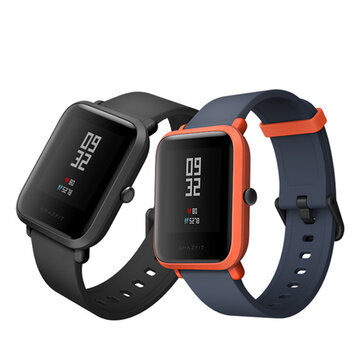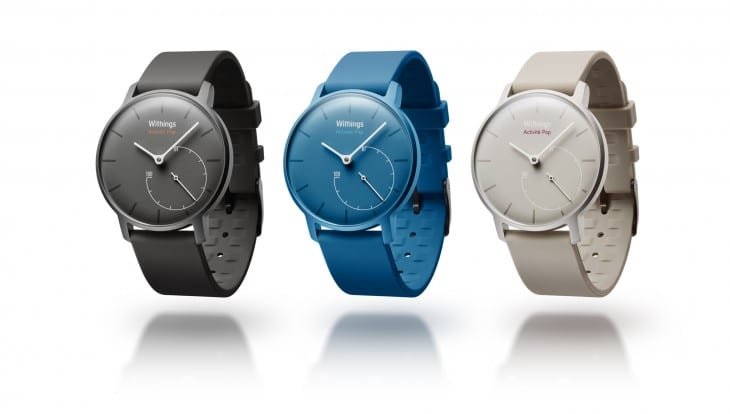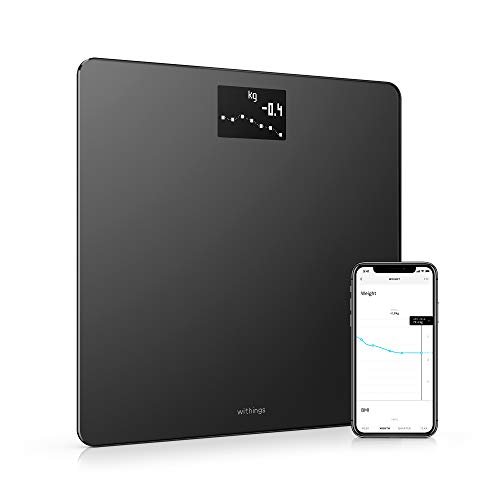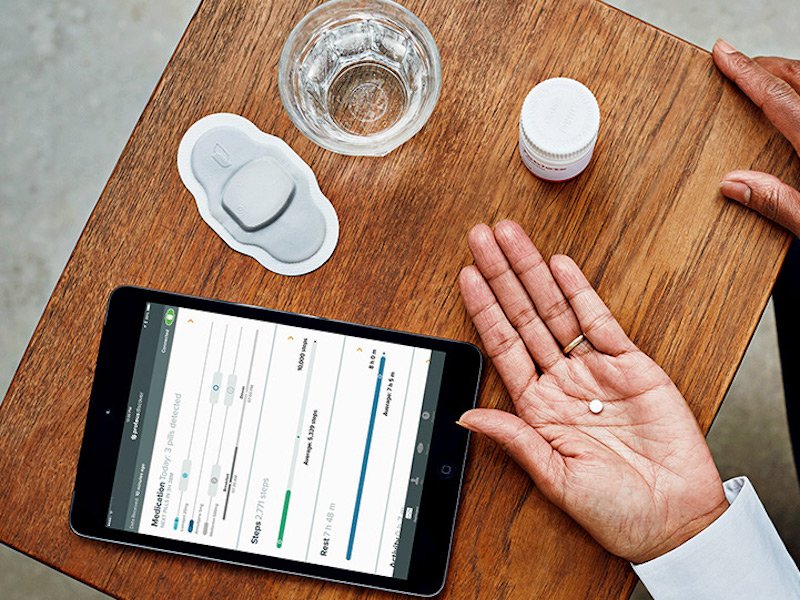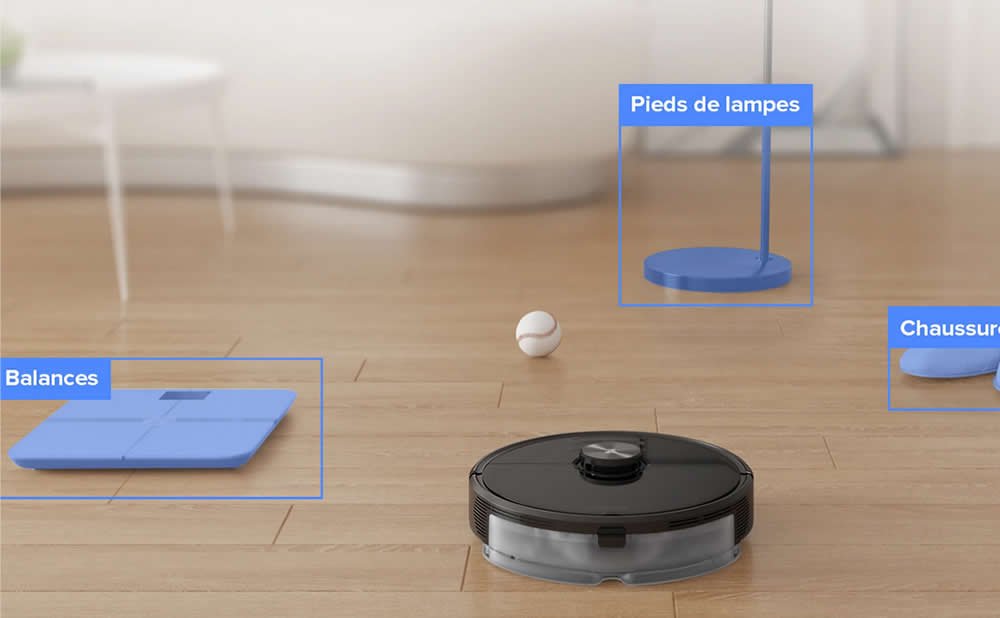The best multisport and triathlon cardio-GPS smart health watches 2019-2020 comparison-Amazfit Stratos vs Garmin Fenix 5 Plus vs Suunto 9 Baro vs Polar Vantage V
If you are wondering which are the best multisport and triathlon cardio-GPS watches in 2024/2020, we think that these 4 models are part of it. We have put face to face in this article the 4 sports watches which seem to us the most complete currently on the market. Three of them are considered Premium or high-end. Released in 2024, they are therefore relatively recent and should still be very successful in 2024.
Full of sensors and rich in functionality, they represent today the top of GPS watches. They are aimed at both the professional sportsperson and the amateur looking to progress or have fun.
It is however difficult for us to say which is the best since it depends above all on the objective, the sport practiced and the expectations of the user without forgetting the budget. Some will seek the precision and reliability of the measurements, others a great autonomy, others a plethora of tools to help the sportsman, others of the ancillary functions used during the sport and in everyday life (music, payment, mapping ), yet others a chic watch that can be worn both in town and for sports! There are also watches that are less complete but better suited and perhaps also less expensive than those in this comparison. We have chosen here to highlight real multisport watches (with change of activity without stopping the watch), intended for triathlon and outdoor.
Note that some of the watches in this comparison exist in several versions (with or without sapphire crystal, with different case sizes, in “luxury” model with titanium bracelet, etc.). We have opted here for a unique model of each watch. Find more details in our tests and reviews of fitness equipment and cardio-GPS watches.
Overview
Garmin Fenix 5 Plus
An improved model of the famous La Fenix 5, the Fenix 5 Plus is a watch with out-of-measure functionality. It is currently the queen of cardio GPS watches but this luxury comes at a price! In addition to numerous sports assistance functions (performance analysis, physiological measurements, tests, coaching, etc.), it offers color mapping, advanced smart health connected functions (live monitoring of other athletes, possibility of being followed online, etc.), sophisticated GPS navigation and enticing features like an mp3 music player, Garmin Pay contactless payment. It has more than 40,000 golf courses. The Fenix 5 Plus exists in 3 versions (5S, 5 and 5X) which differ by their case size and their autonomy. The 5X Plus version also has an oximeter on the wrist (measurement of the blood oxygenation rate). The watch is available with or without sapphire crystal (anti-scratch). Find out more: detailed review and our opinion on the Garmin Fenix 5 Plus


Suunto 9 Baro
This high-end watch with sapphire crystal and integrated barometric altimeter (hence the “baro”) emphasizes autonomy and precision. Thanks to the FusedTrack ™ system, it offers up to 120 hours of autonomy and high accuracy of GPS measurements thanks to the use of accelerometer data to extrapolate the GPS track and thus save battery. It also has an intelligent battery management system to be able to extend the use of the watch according to the route and habits of the user. There is a model without barometer, the Suunto 9. Learn more: detailed review and our opinion on the Suunto 9 Baro

Polar Vantage V
Replacing the famous Polar V800, the Vantage V brings interesting innovations: measurement of wrist power without an external sensor, new revolutionary optical cardio running underwater. It offers advanced sports monitoring functions. This watch should not be confused with the Vantage M which is less sophisticated, more running oriented and significantly cheaper. Find out more: detailed review and our opinion on the Polar Vantage V.

Amazfit Stratos
Comparable to the above high-end watches in terms of functionality but with a certain number of limitations which can be prohibitive depending on the objective sought, this Chinese watch presents an unbeatable value for money. It is the cheapest GPS smart health connected sports watch on the market for the functions offered! Find out more: detailed review and our opinion on the Amazfit Stratos
Price and physical characteristics compared
The price: from simple to quadruple!
The price is often a decisive criterion in the choice of a cardio watch. Aside from the Stratos, which is an exception but which we have retained in this comparison for the richness of its functions, the 3 Garmin, Suunto and Polar watches were sold around or above the psychological bar of $500 . At this price, you must be sure to choose the model that best meets your expectations! The Fenix 5 Plus stands out with a high price, that of a computer, in particular for the model with scratch-resistant sapphire crystal (100 to $ 150 more than the model with ordinary glass). The Stratos, on the contrary, is offered at less than $200 , an unbeatable price, for functions comparable to the most expensive watches on the market today. It is a very good compromise for athletes with a limited budget.
Design, structure and robustness
In terms of design, each watch has its charm with a stainless steel case and a look suitable for both the city and the sport. The type of bracelet (interchangeable or not, with or without tools) and the choice of available materials (silicone, leather, titanium, steel, etc.) are criteria to take into account when choosing your cardio-GPS. Finally, the sapphire crystal (resistant to scratches) is a plus for the protection of your watch in risky sports. However, it adds a little weight (about 10 g) and above all increases the price (count at least $100 more).
- Fenix 5 Plus: we particularly appreciate this model for its 3 case sizes (42, 47 and 51 mm) for adaptation to all wrists, in particular thin wrists! Finally a high-end cardio watch that knows how to be discreet. The bracelet is interchangeable without tools. In addition, the brand offers chic leather, steel and titanium bracelets in addition to the silicone bracelet provided for sports. The scratch-resistant sapphire crystal is available as an option except on the 5X Plus model. It very effectively protects the screen from scratches, an interesting point for sports where friction is frequent.
- Suunto 9 Baro: Suunto offers a robust model with a single case size (51 mm), the size of the largest model of the Fenix 5 Plus (51 mm) but several bracelet sizes to adapt to all body types. The watch’s glass is made of sapphire, the hardest material that exists after diamonds! The bracelet is interchangeable without tools but only exists in silicone version.
- Vantage V: unlike the Vantage M, the strap of the Vantage V is not interchangeable. The watch comes in a nice round stainless steel case, unlike the brand’s previous models. The glass is made of Gorilla corning, an ultra-resistant glass.
- Stratos: a nice look also for this watch whose strap is interchangeable without tools. The Stratos + version offers a leather strap and a spare silicone strap as well as a sapphire crystal.
The screen
More and more watches offer a touch screen, color and high resolution. This is explained by the multiplication of data displayed, the customization of watches with the display of wallpapers and the arrival of cartography. For the 4 watches selected, the size and resolution of the screens vary significantly. Suunto and Amazfit offer a wide screen. Garmin and Polar favored a more discreet design better suited to small wrists.
Suunto and Amazfit offer a large, color touch screen (35 mm in diameter) and a resolution of 320 x 300 px, which, over time, should become widespread on high-end watches. For their part, Garmin and Polar remained on an intermediate screen of 30.4 mm (1.2 “) and 240 x 240 px, which is already a good resolution but a bit limited for the Garmin and its mapping. We regret also the absence of a touch screen for this type of functionality!

Weight and thickness
Weight and thickness are important criteria depending on the sport. A light and thin watch is less felt on the wrist than a bulky and heavy watch. The Fenix 5 Plus and the Suunto 9 are among the “heavyweights” with 76 g for the Garmin (86 g with a sapphire glass and up to 96 g for the Fenix 5X Plus!) And 81 g for the Suunto 9 ( 72 g for the version without barometer). Note that the sapphire crystal adds 10 g to the weight of the watch.
The Vantage and the Stratos all seem light alongside (66 g and 60 g respectively). The 60 g of the Stratos is a surprise given the sensors it has on board and its more than honorable autonomy. These models are better suited for sports use aimed at performance while the Suunto 9 and Fenix 5 Plus are more intended for exploration, adventure, outdoor.
Note that of the 4 watches, the Vantage V is the thinnest with a reasonable thickness of 13 mm compared to the 15.8 mm of the Fenix 5 and 17 mm of the Suunto 9. It must be said that it has fewer components than the other watches.
Autonomy: Suunto 9 stands out!
Autonomy is today an important criterion in the choice of a cardio-GPS watch. It is even an eliminatory criterion for the followers of races of type “ultra” with durations of use which can largely exceed the 40 h. For shorter outings, autonomy also remains an essential criterion: what a frustration to run out of battery during an outing because you forgot to charge your watch the day before!
| Model | Fenix 5 Plus | Suunto 9 Baro | Vantage V | Amazfit Stratos |
|---|---|---|---|---|
| Watch mode | 12 d | 14 d | 30 days | 5 d |
| GPS mode | 6 p.m. | 25 hrs | 40 hrs | 35 hrs |
| UltraTrac mode | 42 h | 120 h | ||
| Rechargeable during the activity |
•
|
•
|
•
|
Record autonomy and reliability of Ultra mode measurements for Suunto
The number of sensors and functions on board cardio-GPS watches is increasing steadily, resulting in increased energy consumption. It is especially the GPS chip which is very greedy. To save battery and extend battery life, manufacturers sometimes offer an energy saving function (ultra mode) which consists of spacing out GPS readings. This decreases the accuracy of the measurements all the more. The manufacturers of GPS chips, for their part, are working to reduce the consumption of their chip, sometimes to the detriment of the accuracy of the measurements … That said, the Broadcom company announced in 2017 the release of a much more precise chip ( about 20-30 cm instead of 2 to 10 m currently) for a consumption 2 times lower. It is starting to equip our smartphones and may soon be able to integrate cardio watches!

Suunto, for its part, offers a revolutionary solution (FusedTrack ™ function): an energy saving mode which does not alter the accuracy of the measurements too much. Thanks to the combination of data from the GPS, accelerometer, gyroscope and compass, Suunto “guesses” the missing measurements from the GPS to finally obtain an accurate trace. This allows you to go from 25 hours of autonomy to 40 or 120 hours! Suunto 9 also offers intelligent battery management based on previous trips and user choices. It is thus possible to request an “extension” of autonomy to make an unexpected detour without running out of juice! In addition to these innovations, Suunto uses a more energy-efficient Sony GPS chip.
Polar surprises us with an announced autonomy of 40 hours in GPS mode 1 second. This good result comes mainly from the use of the Sony chip which consumes less energy than the SiRF chip on board the old Polar V800 model. We regret however that the watch does not offer any energy saving mode as was possible on the V800 or other older models. Polar seems to believe that 40 hours of autonomy is enough!
The Stratos is also doing well with 35 hours announced and a full recharge in 2 hours.
Far behind, the Garmin Fenix 5 Plus has only 18 hours of battery life (42 hours in ultraTrac mode). To get more without losing precision, you must opt for the Fenix 5X Plus (32 hours of autonomy in GPS mode 1 second or 70 hours in ultraTrac mode).
Charging without stopping the watch
Another positive point for 3 of the watches in our comparison: the Fenix 5 Plus, the Suunto 9 and the Stratos can be recharged during the activity, without stopping the watch. However, it will need to be removed from the wrist for a break because all 3 are recharged via a connector located under the watch. The Polar, on the other hand, must be stopped to be charged.
The sensors
The top-of-the-range watches are full of sensors which provide numerous measurements on the environment and on the physiology of the sportsman. Certain sensors may be superfluous depending on the sport practiced. The 4 watches compared are multisport and specially designed to be versatile. The on-board sensors are intended in particular for triathlon and its activities, outdoor (adventure, hiking, trekking, exploration) and of course many other indoor and outdoor activities
| Model | Fenix 5 Plus | Suunto 9 Baro | Vantage V | Amazfit Stratos |
|---|---|---|---|---|
| Barometer |
•
|
•
|
•
|
•
|
| Barometric altimeter |
•
|
•
|
•
|
•
|
| Manual altimeter calibration |
•
|
•
|
•
|
|
| Altitude combining GPS and barometer |
•
|
|||
| GPS systems | GPS, GLONASS, Galileo | GPS | GPS, GLONASS | GPS, GLONASS |
| Wrist cardio |
•
|
•
|
•
|
•
|
| Power | With external sensor | With external sensor |
•
|
With external sensor |
| Compass |
•
|
•
|
•
|
|
| Pulse oximeter | Fenix 5X Plus | |||
| Thermometer |
•
|
•
|
||
| Weather functions |
•
|
•
|
||
| Compatibility of external sensors | ANT +, Bluetooth | Bluetooth | Bluetooth |
The barometer: thunderstorm alerts on Suunto and Garmin
The 4 models are equipped with a barometer. It allows you to measure atmospheric pressure, deduce altitude, measure elevation and detect changes in weather. Garmin and Suunto offer thunderstorm alerts triggered in the event of a sudden change in pressure, a plus for hikers.
The altimeter: barometric for the 4 models, mixed at Suunto
Essential for measurements of altitude and elevation in particular, it can be barometric (altitude deducted from atmospheric pressure measured by an internal barometer) or operate from GPS measurements. For good accuracy, the ideal is that it be barometric. This is the case of the 4 models compared.
As the pressure changes over time, it is preferable that the altimeter can be calibrated manually. This is not the case with the Vantage and it is a shame. Suunto, for its part, goes further by combining data from the GPS and the barometric altimeter for increased accuracy and reliability of altitude and elevation readings (FusedAlti ™ algorithm).
GPS: GPS, GLONASS, Galileo: inequalities with no real impact
A few years ago, GPS watches operated on a single satellite network, the American system (GPS). Today, other systems are accessible such as the Russian (GLONASS), Japanese (QZSS or Michibiki) or European (Galileo) satellite systems. Having more satellites improves the acquisition time but not necessarily the accuracy. Manufacturers offer chips compatible with several satellite systems, but watch manufacturers do not always exploit these possibilities. There are several reasons for this. The use of several systems adds to the consumption of the watch. On the other hand, the position reading is done with a single satellite network and not a mix of several networks, which means that the accuracy can be less good than with a single system (for example if the GLONASS is received in first by the watch where the GPS would have given better accuracy).
If the Suunto Spartan (predecessor of the Suunto 9) offered GPS and GLONASS (see our comparison Suunto 9 versus Spartan), the Suunto 9 is only compatible with GPS. Suunto made this choice to save the battery without losing precision (the GLONASS is more useful in town, which is not the place of a standard use of this watch). Garmin, for its part, operates the GPS, GLONASS and Galileo systems.
These differences between the 4 watches is not significant. If necessary, manufacturers can always activate compatibility with GLONASS or Galileo via a firmware update. The accuracy of the measurements is more linked to the GPS chip and to the software developed by each watch manufacturer to exploit its data. Note that the Sony chip, used in Vantage and Suunto, consumes less energy than the chip offered by SiRF Technology, but it is less precise.
Cardio optics: a step ahead for Polar
Polar has always been the leader in measuring heart rate and its variability. It is the Finnish company which developed the first cardio sensor (measurement with the finger then by thoracic belt).
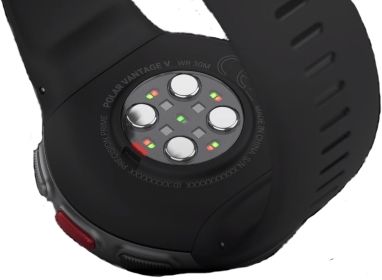
On the Polar Vantage, Polar uses an innovative sensor with 9 LEDs, 4 electrodes and 4 sensors to improve the quality of the measurements, especially in difficult conditions (aquatic environment, interval sessions, profuse sweating, thick skin, etc.). The cardio monitoring ensures in particular that the sensors are in good contact with the skin.
Thanks to this revolutionary system, the measurement of the heart rate is more reliable and is made possible where other optical cardios fail, for swimming for example. On the other hand, if you cannot do without your HRM-Tri or HRM-Swim belt to swim, you will have to find another watch because Polar has removed this possibility on the Vantage V!
According to user feedback, this new optical heart rate monitoring is not yet fully developed. Be aware anyway that an optical pulse measurement system will never be as accurate as a chest strap.
Power: a step ahead at Polar!
Each of the 4 watches makes it possible to estimate the power developed during running. To do this, you must couple a power sensor to the watch (Stryd sensor, Foodpod, HRM-Run or HRM-Tri belt, etc.). Only the Vantage V is an exception. It is the first watch to integrate power measurement without an external sensor. The estimate is made using the watch’s sensors: accelerometer, GPS, altimeter. Power is estimated from the assessment of kinetic and potential energy (more details in our article on the Polar Vantage V). Of course, the measurements are approximate, but as much as those obtained with an external sensor. Polar is therefore one step ahead of the competition here.
The other sensors
ABC sensors (altimeter, barometer, compass) are essential for hiking and exploring. These sensors are present on the 4 watches except on the Vantage V which does not have a compass.
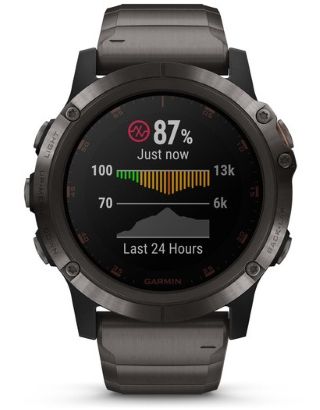
Garmin stands out from the competition for its pulse oximeter. This sensor, available only on the Fenix 5X Plus, is integrated into the optical heart rate monitoring. It measures the rate of blood oxygenation, a parameter to monitoring for high altitude sport (mountaineering for example) and for divers. The watch can detect a lack of oxygenation and alert the athlete in the event of an accident risk.
In addition to the ABC sensors, the Fenix 5 Plus and the Suunto 9 carry a thermometer. They also offer weather functions (trend, thunderstorm alerts, sunrise and sunset times).
The external sensors
Today, 2 standards are used to connect a GPS watch to an external sensor: ANT + (a low energy consumption wireless protocol developed by a subsidiary of Garmin) and Bluetooth. ANT + is used less and less. Among the 4 watches compared, only the Fenix 5 Plus supports it, hence compatibility with almost all current sensors. If you have ANT + sensors, these will not work with Suunto 9, Vantage V or Stratos. For the Stratos, it is even more limited: it is not compatible with any external sensor except the Bluetooth chest belts.
Compared features
| Model | Fenix 5 Plus | Suunto 9 Baro | Vantage V | Amazfit Stratos |
|---|---|---|---|---|
| GPS navigation |
+++
|
++
|
To come up |
+
|
| Nb of sports | 22+ | 80+ | 130+ | 14 |
| Triathlon |
•
|
•
|
•
|
•
|
| Golf | 40,000 courses | |||
| Integrated route generator |
•
|
|||
| Training schedule |
•
|
•
|
•
|
Running only |
| Split |
•
|
•
|
To come up |
•
|
| Training tracking |
•
|
•
|
•
|
•
|
| Physiological measurements |
•
|
•
|
•
|
|
| – VO2max |
•
|
•
|
•
|
|
| – Race predictor |
•
|
|||
| – Training effect |
•
|
•
|
•
|
|
| – Lactic threshold |
•
|
|||
| – Recovery time |
•
|
•
|
•
|
|
| – Training load |
•
|
•
|
•
|
|
| – Training status |
•
|
•
|
•
|
|
| Race dynamics (ex: cadence, stride length …) | 7 | 2 | 2 | 0 |
| Altitude profile |
•
|
•
|
||
| Virtual partner |
•
|
|||
| Strava Live segments |
•
|
To come up |
•
|
|
| smart health connected functions |
+++
|
++
|
To come up |
++
|
| Activity monitoring |
+++
|
++
|
+
|
++
|
| Mp3 player |
•
|
•
|
||
| Contactless payment | China only | |||
| Cartography |
•
|
|||
| Pulse oximeter | Fenix 5X Plus |
Navigation: the ultimate with the Fenix 5 Plus
GPS navigation (route tracking, route planning, return to departure, navigation to waypoints, etc.) is an essential function for hiking, exploring, trekking but also for organizing a bike or running outing on unknown paths.

At this level, the Fenix 5 Plus clearly stands out with a complete navigation tool, the color mapping of the country or continent of purchase (city maps, roads, bike paths, paths, hiking maps with contour lines according to the options), the possibility of letting the watch propose a loop route, on road or cycle paths, from a given distance or even to propose a route recorded by other users of the Garmin community (Trenline function), possibility of obtaining the route profile (ClimPro function), route recalculation when deviating from a planned route. It also allows you to find a hotel, a refuge, an inn around you. She is really excellent for that.
In addition to these functions, Garmin has generalized the LiveTrack function on its watches, which allows it to be followed on the Internet. The Fenix 5 Plus also offers the GroupTrack function to follow other athletes wearing a Garmin watch that has this function.
The Suunto 9 also offers advanced navigation functions (route tracking, navigation to waypoints, waypoint records, small thumb track, return to departure, estimated arrival time, altimetry profiles, climb speed, etc. ).
The Stratos allows you to follow a route and to be guided and even alerted if you leave the track.
The Polar Vantage V, on the other hand, suffers from the complete lack of navigation functions (no route guide, no return to the starting point, no GPS track, no navigation to waypoints). But Polar announces that these functions will be integrated in 2024 by a firmware update.
Sport profiles and sports functions
These high-end watches all offer many sporting profiles, up to 130 for the Vantage! The number of profiles does not necessarily indicate that the watch is more complete. With Polar (130 profiles) and Suunto (80 profiles), each profile is similar with generic data (distance, GPS track, calories expended, etc.). Sometimes it’s just the name of the sport that changes!
At Garmin, each profile is studied to provide relevant data for each sport: race dynamics for running, number of strokes and cadence for rowing, number of descents for skiing, etc. The Garmin Fenix 5 Plus, with its dozen profiles, is ultimately more complete than Polar or Suunto. Also note that it is well suited to the practice of golf with more than 40,000 on-board courses and specific functions for this sport.
In addition to the profiles, the Fenix 5 Plus and the Stratos provide training functions: training programming (only for running for the Stratos), taking into account previous outings, split, sew against an opponent or against yourself for Garmin, audio coaching, alert programming, goal setting, etc. These watches are very complete. These functions, combined with physiological measurements, offer powerful tools for demanding athletes.
Polar also offers training programs (but not yet interval training), taking into account physiological measures to advise the athlete (see below). Too bad the ZoneLock function, which used to set heart rate, speed or power goals, is no longer offered.
At Suunto, sports functions are much more limited. The focus is on autonomy, reliability and outdoor functions.
Physiological measurements and running dynamics
Increasingly present on sports watches, physiological measures help athletes to manage their training and optimize their performance or even predict a race time (function offered by the Fenix 5). From the measurement of the heart rate and its variability and other parameters (power, cadence, etc.), the watch can estimate the physical condition of the athlete, his VO2max, his physiological age, his stress level, the training level, the effect of training on the body (training effect, status and training load, etc.). At Garmin, we can even predict a race time depending on the distance to be covered, the level of training and the physical condition of the athlete.
The company Firstbeat offers an algorithm to exploit this data. Garmin uses it on his latest watches as well as Amazfit in his Stratos. The 2 watches therefore offer similar functions (a little more complete at Garmin).
Polar also offers advanced monitoring and assistance functions for athletes such as VO2 max (OwnIndex) and especially the new Training Load Pro ™ and Recovery Pro ™ functions. These advanced functions allow you to properly manage your training and recovery. They take into account previous outings, cardiovascular load and muscle load, a first.
In addition to physiological measurements, Garmin and Amazfit offer running dynamics, advanced functions for runners: running power, stride length, cadence, ground contact time, vertical oscillation, contact time balance on the ground, vertical ratio and more.
smart health connected functions
Each of the watches offers more or less advanced functions. The minimum of current smart health connected watches is to offer smart notifications (notification of emails, calls and SMS). Vantage does not offer it yet. The Fenix 5 still stands out with the possibility of refusing incoming calls from a Smartphone or sending predefined SMS. It offers LiveTrack and GroupTrack functions, the possibility of listening to music locally or in streaming with Spotify or Deezer, the possibility of paying for small purchases (Garmin Pay function), the control of compatible devices (3D VIRB camera, etc.). It can also connect via Wifi (like the Stratos).
Activity monitoring
The watch measures your daily activity and even your sleep if you wear it 24 hours a day. It informs you of your activity (number of steps, distance traveled, calories expended, etc.) and encourages you to move. Garmin offers comprehensive functions, including stress level assessment, the number of climbed stages. The Polar Vantage V is the least supplied of the 4 watches.
Additional functions
These functions can make the difference in choosing a cardio watch, although some may seem a little gimmicky and add price to the watch.
- Color mapping: only Fenix 5 offers this function. The cards are embedded in the gigantic memory of the watch.
- A music player: present on the Amazfit Stratos and the Fenix 5 Plus, it allows you to listen to your favorite music without a Smartphone thanks to Bluetooth headphones
- A payment system: only the Fenix 5 Plus and the Amazfit Stratos (in China only) offer this function. It allows you to pay for small purchases without having to use your smartphone or a bank card. Payment is made using an on-board NFC chip.
- A pulse oximeter (or saturometer): available only on the Fenix 5X Plus, it measures the blood oxygen level and helps to prevent accidents at high altitude (see above).
Our opinion on these 4 multisport cardio-GPS watches: which is better?
It is difficult for us to say which of these 4 watches is the best multisport cardio-GPS watch since it depends on the budget targeted (from simple to quadruple depending on the model), the type of main sport practiced (our selection is nevertheless based on the triathlon activity) and the objective sought (performance, reliability, number of data, specific functions sought, comfort, etc.).
The Garmin Fenix 5 Plus is undoubtedly the most complete watch on the market today, whether in terms of sensors, functionalities, physiological measurements, GPS navigation, user-friendliness of the interface. It is ultra-complete, rich in sports monitoring and assistance to optimize performance. GPS navigation, route planning directly on the watch, finding a site of interest in the surroundings (refuge, restaurant, etc.), color mapping are simply stunning. It offers attractive additional functions: an on-board MP3 player to listen to music without having to carry a Smartphone (ideal for running light!), A contactless payment function to be able to buy, empty pockets, a drink or a snack in on the road! It is the ideal companion for outdoor outings, hiking, trekking. It is also the most complete watch for triathlon and an ideal companion for training.In addition, it adapts to all wrist sizes, a definite asset for people with thin wrists and those looking for a watch discreet enough to be able to be worn on a daily basis. Garmin also offers chic bracelets for the city and work and an easy attachment system (without tools). Hard to beat ! The other side of the coin is its high price, a little low autonomy for the ultra and average precision for the cardio optics and the GPS. Read our detailed review and full review of the Garmin Fenix 5 Plus. For use exclusively dedicated to triathlon, we recommend the Garmin Forerunner 935, a very complete triathlon watch, lighter than the Fenix 5 Plus and cheaper (but less chic too).
The Suunto 9, with clearly less developed functions, however, is a highly sought-after watch for its record autonomy (120 h) and the precision of the GPS track despite the energy saving mode. The innovative FusedTrack ™ system makes it possible to offer the reliability of the GPS track (even when the signal is sometimes lacking) while offering the impressive autonomy that ultra racing fans are looking for. Intelligent battery management is also a great innovation. It allows you to change the mode at any time to extend the autonomy without significantly altering the accuracy of the trace. No more compromises between battery life and data accuracy! Finally, the FusedAlti ™ and FusedSpeed ™ functions are a plus over the competition. The Suunto 9 is also pretty and robust. It is more suitable for outdoor, hiking, trail running and of course all long (ultra) running, multi-day outings, trekking. Too bad the functions offered are not more developed. Read our detailed review and our full review on Suunto 9.
The Polar Vantage V will appeal to athletes looking for a powerful training assistant. The new Training Load Pro and Recovery Pro functions and the measurement without power sensor developed for running are perfect for demanding athletes, whether pros or training like pros. It is very good for athletes who want to optimize their performance. Its innovative optical sensor allows use in difficult conditions (swimming, interval training, cycling, etc.) but needs to be improved. It is well suited to the practice of triathlon. It offers excellent autonomy. This watch, released a little too early, still lacks a bit of maturity. GPS accuracy is not as good as the previous version (Polar V800), some useful features have disappeared, it offers no GPS navigation function, smart notifications, watchfaces, or energy saving mode . Hopefully Polar will quickly make some fixes to improve this aspect. Read our detailed review and our full review on the Polar Vantage V.
Finally, the Amazfit Stratos is attractive for its unbeatable price and its many on-board functions including the physiological measurements and racing dynamics offered by the Fenix 5 Plus. It also offers an on-board MP3 player and a payment function, which is currently only available in China. It suffers from some anomalies and limitations that the price can justify. It is a good compromise for people on a limited budget. Read our detailed review and our full review on the Amazfit Stratos.
| Model | Pros | Cons |
|---|---|---|
| Fenix 5 Plus | Very complete Numerous sports aid functions Physiological measurements Race dynamics Advanced GPS navigation Color mapping Integrated route generator Mp3 player Payment system |
No touch screen GPS accuracy to improve A little fair autonomy |
| Suunto 9 Baro | Autonomie record Intelligent battery management Quality of measurements (fusedAlti, FusedTrack, FusedSpeed) Advanced GPS navigation Practical gauges (light crown) |
Few new functions Lack of physiological measures |
| Vantage V | Wrist power measurement Optical sensor Training Load Pro and Recovery Pro functions Autonomy Elegance |
No manual altimeter setting No energy saving mode No Smart notifications No GPS navigation |
| Amazfit Stratos | Value for money Physiological measurements Mp3 player |
Reliability of measurements Some annoying bugs Payment system unusable in Europe English interface No interface for PC or Mac Incompatibility with external sensors |
Buy the Suunto 9 for Best Price
Buy the Polar Vantage V for Best Price
Buy the Amazfit Stratos for Best Price
Buy the Garmin Fenix 5 Plus for Best Price
Read also
Fenix 5 vs Forerunner 935: which one to choose?
AB SMART HEALTH REVIEW










